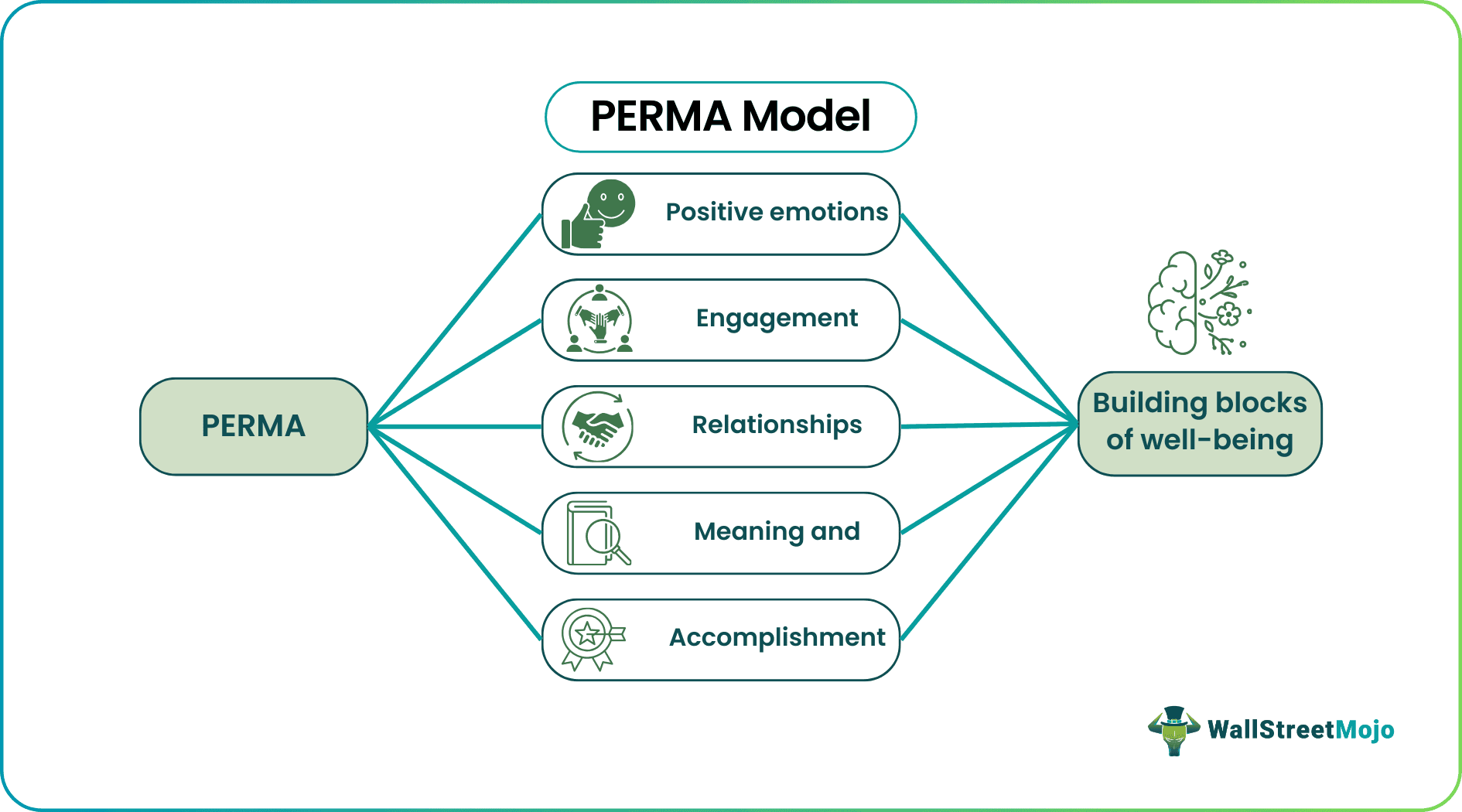Table Of Contents
Key Takeaways
- The PERMA model, created by psychologist Martin Seligman, is a psychological framework aimed at comprehending, fostering, and attaining happiness and well-being in human life.
- Its goal is to advocate for a holistic approach to well-being, encompassing all facets of life through its five key elements: positive emotions (P), engagement (E), relationships (R), meaning (M), and accomplishment (A).
- The model identifies five elements of well-being to enhance life and productivity. Still, its complexity and potential negative impacts require careful consideration, yet it positively influences employee well-being and financial decision-making.
- Although supported by evidence-based research from reputable psychological researchers, the model lacks a universal framework for application to all individuals and situations.
What Is PERMA Model?
The PERMA model is a psychological framework developed by psychologist Martin Seligman to understand, promote, and achieve happiness and well-being in human life. Its objective is to propagate an all-encompassing approach to well-being, covering positive emotions (P), engagement (E), relationships (R), meaning (M), and accomplishment (A).

These elements are essential for individuals to thrive and flourish in their lives, leading to a better, more content, and meaningful existence. The PERMA model has been utilized in various settings, including personal development programs, workplaces, and schools, to foster a positive environment and enhance overall life satisfaction.
PERMA Model Explained
The PERMA model of well-being is presented as a theory and framework developed to thrive and flourish in various aspects of life, including offices and schools, addressing various challenges. It encompasses five main elements: emotions, engagement, meaning, and accomplishment. The underlying principle of the PERMA model is a strengths-based approach, training individuals to focus on the positive aspects of their lives rather than the negative. Individuals and organizations employ this approach to improve their and employees' well-being.
The model operates by helping individuals identify and focus on essential areas of their lives through its five elements. People are encouraged to pursue activities that bring love, joy, and gratitude. If relationships are found lacking, individuals are advised to concentrate on improving connections with their loved ones. The model has both pros and cons. On the positive side, it promotes a focus on a positive life, considers five elements of well-being for all-around prosperity, and encourages adaptability to diverse situations. However, it may be complex and challenging to apply in certain situations, might not positively impact individuals' lives in unique situations, and may not be a solution for most mental illnesses.
The PERMA model positively impacts employee productivity and well-being in the financial world. Companies implementing the model in their workspace experience higher employee satisfaction, increased productivity, and lower attrition rates. Correctly implemented, it can contribute to sound financial and operational decision-making by management.
Elements
The PERMA model framework comprises five elements necessary for positive and optimal mental status:
- Positive Emotions: Focuses on cultivating positive feelings like contentment, joy, love, and gratitude, reducing stress, improving physical health, and boosting cognitive function.
- Engagement: Involves being in a mental state fully immersed and in continuous flow in challenging and captivating activities, resulting in satisfaction and enjoyment for overall well-being.
- Relationships: Relates to having strong bonds and meaningful connections in life to foster social support and a sense of well-being, aiding in coping with adversity and stress.
- Meaning: Deals with an individual finding importance and meaning in their actions and experiences, providing a deeper sense of fulfillment, purpose, and a definite path to success.
- Accomplishment: Involves setting and fully trying to achieve practical objectives, leading to an appreciation of self-worth, satisfaction, and accomplishment.
All these elements help individuals achieve satisfaction, happiness, health, wealth, and wisdom in all aspects of life.
Examples
Let's look into a couple of PERMA model examples:
Example #1
Suppose in an adventure club setting, members wholeheartedly embrace the PERMA concept. Fun activities like rock climbing and hiking are designed to create positive feelings (P) when overcoming challenges. Playful team-building exercises strengthen relationships and foster friendships (R). Their shared love for exploration strengthens their bond with nature, providing a deep sense of significance (M). Conquering tough treks instills a profound sense of success (A).
Example #2
The PERMA concept is the heart of the delightful and imaginary Joyful Cafe, offering a charming experience. The cafe's lively decor and vibrant ambiance evoke positive feelings (P). Engaging activities like open mic nights build connections and bring laughter (R). Special culinary challenges, like the "towering cake challenge," provide a sense of accomplishment (A). With a mission to spread joy (M), every visit to the cafe holds a meaningful purpose.
Advantages And Disadvantages
The advantages and disadvantages of the PERMA model are the following:
Advantages:
- PERMA provides detailed guidelines for understanding and implementing well-being and happiness.
- It focuses on multiple facets of life, contributing to holistic happiness.
- Individuals can identify areas for personal growth and improvement.
- It helps increase the quotient of well-being and happiness.
- PERMA alleviates anxiety and stress by aligning individuals with positive psychology guidelines.
- Many people use it to improve their relationships with others.
- Individuals have found meaning in their lives and achieved their goals.
- The model has the backing of evidence-based research from reputable psychological researchers.
Disadvantages:
- It may generalize individual experiences and complex mental health issues.
- Implementation may depend on individual differences and culture.
- A few elements become challenging to measure objectively.
- Equal application of the five elements may be quite difficult.
- It becomes time-consuming to focus on all elements of the model.
- It may not suit everyone and may not be effective for all individuals.
- The model remains ineffective for individuals suffering from severe psychological issues like Schizophrenia.
- It lacks a framework for universal application and is restrictive in its application to mental health patients.

